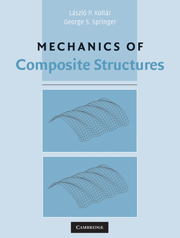Book contents
- Frontmatter
- Contents
- Preface
- List of Symbols
- 1 Introduction
- 2 Displacements, Strains, and Stresses
- 3 Laminated Composites
- 4 Thin Plates
- 5 Sandwich Plates
- 6 Beams
- 7 Beams with Shear Deformation
- 8 Shells
- 9 Finite Element Analysis
- 10 Failure Criteria
- 11 Micromechanics
- Appendix A Cross-Sectional Properties of Thin-Walled Composite Beams
- Appendix B Buckling Loads and Natural Frequencies of Orthotropic Beams with Shear Deformation
- Appendix C Typical Material Properties
- Index
3 - Laminated Composites
Published online by Cambridge University Press: 01 September 2009
- Frontmatter
- Contents
- Preface
- List of Symbols
- 1 Introduction
- 2 Displacements, Strains, and Stresses
- 3 Laminated Composites
- 4 Thin Plates
- 5 Sandwich Plates
- 6 Beams
- 7 Beams with Shear Deformation
- 8 Shells
- 9 Finite Element Analysis
- 10 Failure Criteria
- 11 Micromechanics
- Appendix A Cross-Sectional Properties of Thin-Walled Composite Beams
- Appendix B Buckling Loads and Natural Frequencies of Orthotropic Beams with Shear Deformation
- Appendix C Typical Material Properties
- Index
Summary
Composites are frequently made of layers (plies) bonded together to form a laminate (Fig. 3.1). A layer may consist of short fibers, unidirectional continuous fibers, or woven or braided fibers embedded in a matrix (Figs. 1.1 and 1.2). A layer containing woven or braided fibers is referred to as fabric.
Adjacent plies having the same material and the same orientation are referred to as a ply group. Since the properties and the orientations are the same across the ply group, a ply group may be treated as one layer.
Laminate Code
An x, y, z orthogonal coordinate system is used in analyzing laminates with the z coordinate being perpendicular to the plane of the laminate (Fig. 3.2).
The orientations of continuous, unidirectional plies are specified by the angle Θ (in degree) with respect to the x-axis (Fig. 3.2). The angle Θ is positive in the counterclockwise direction. The number of plies within a ply group is specified by a numerical subscript. For example, the laminate consisting of unidirectional plies and shown in Figure 3.3 is designated as
[453/04/902/60].
This laminate contains four ply groups, the first containing three plies in the 45-degree direction, the second containing four plies in the 0-degree direction, the third containing two plies in the 90-degree direction, the fourth containing one ply in the 60-degree direction.
Symmetrical laminate. When the laminate is symmetrical with respect to the midplane it is referred to as a symmetrical laminate. Examples of symmetrical laminates are shown in Figure 3.4.
Information
- Type
- Chapter
- Information
- Mechanics of Composite Structures , pp. 63 - 88Publisher: Cambridge University PressPrint publication year: 2003
